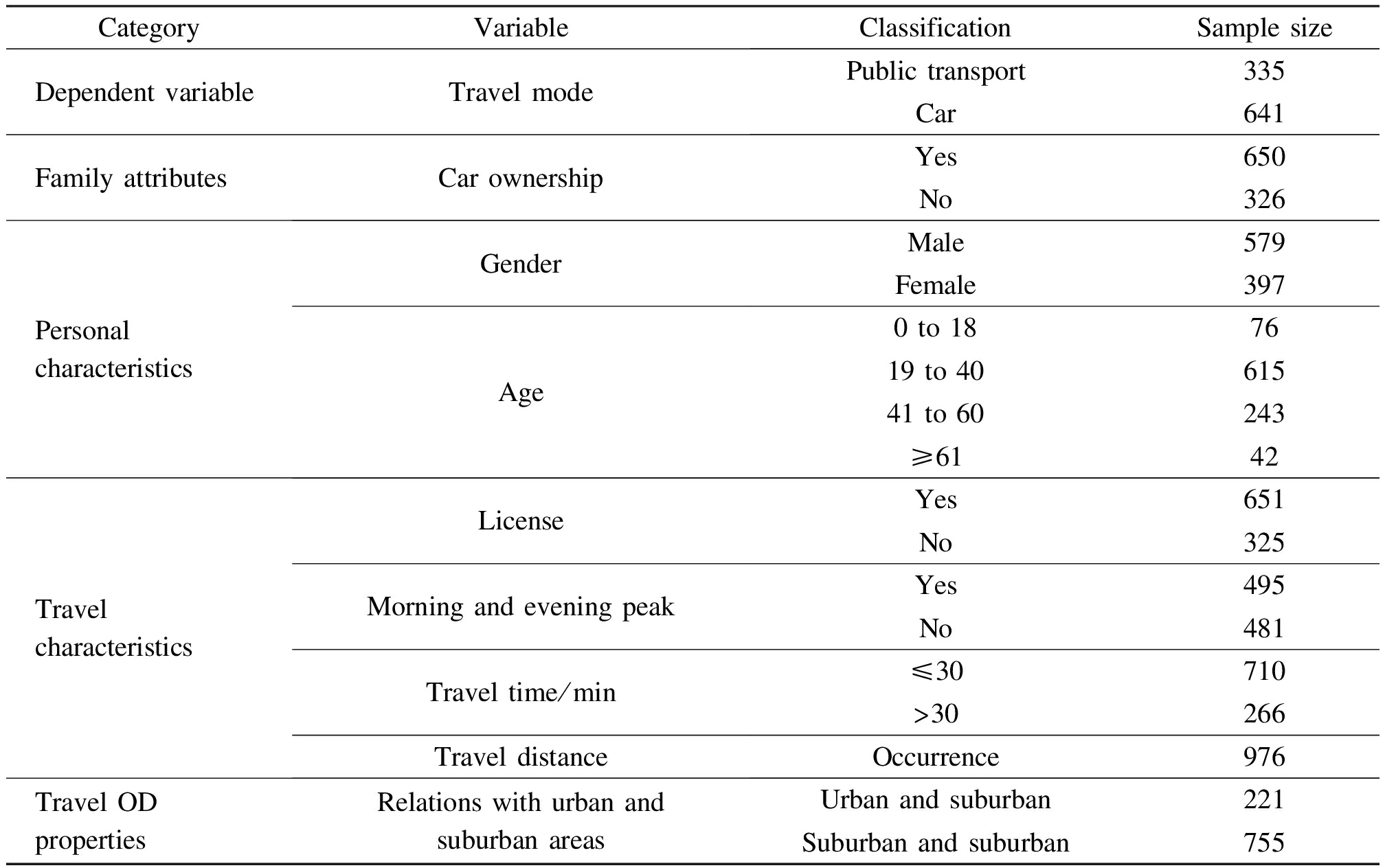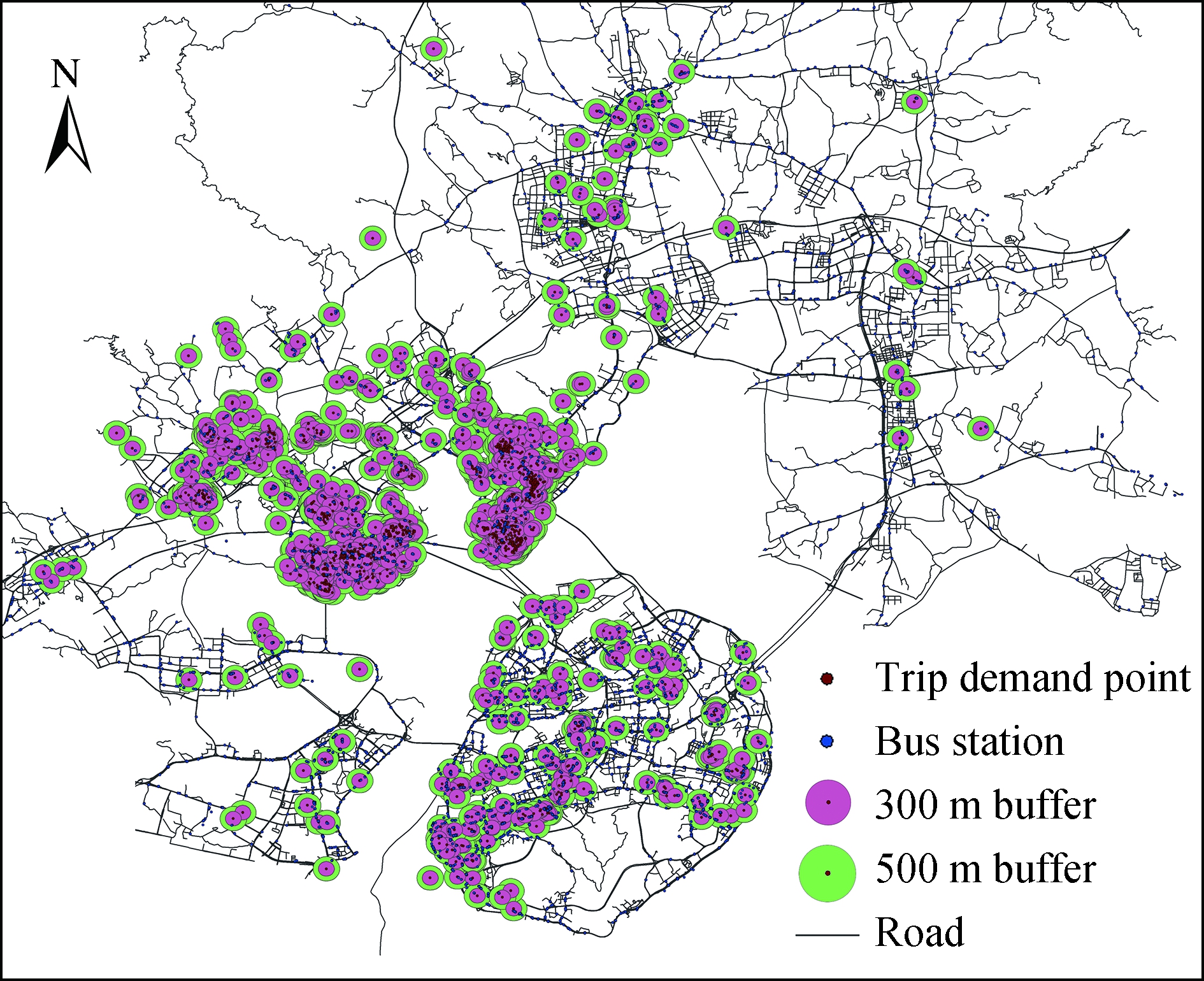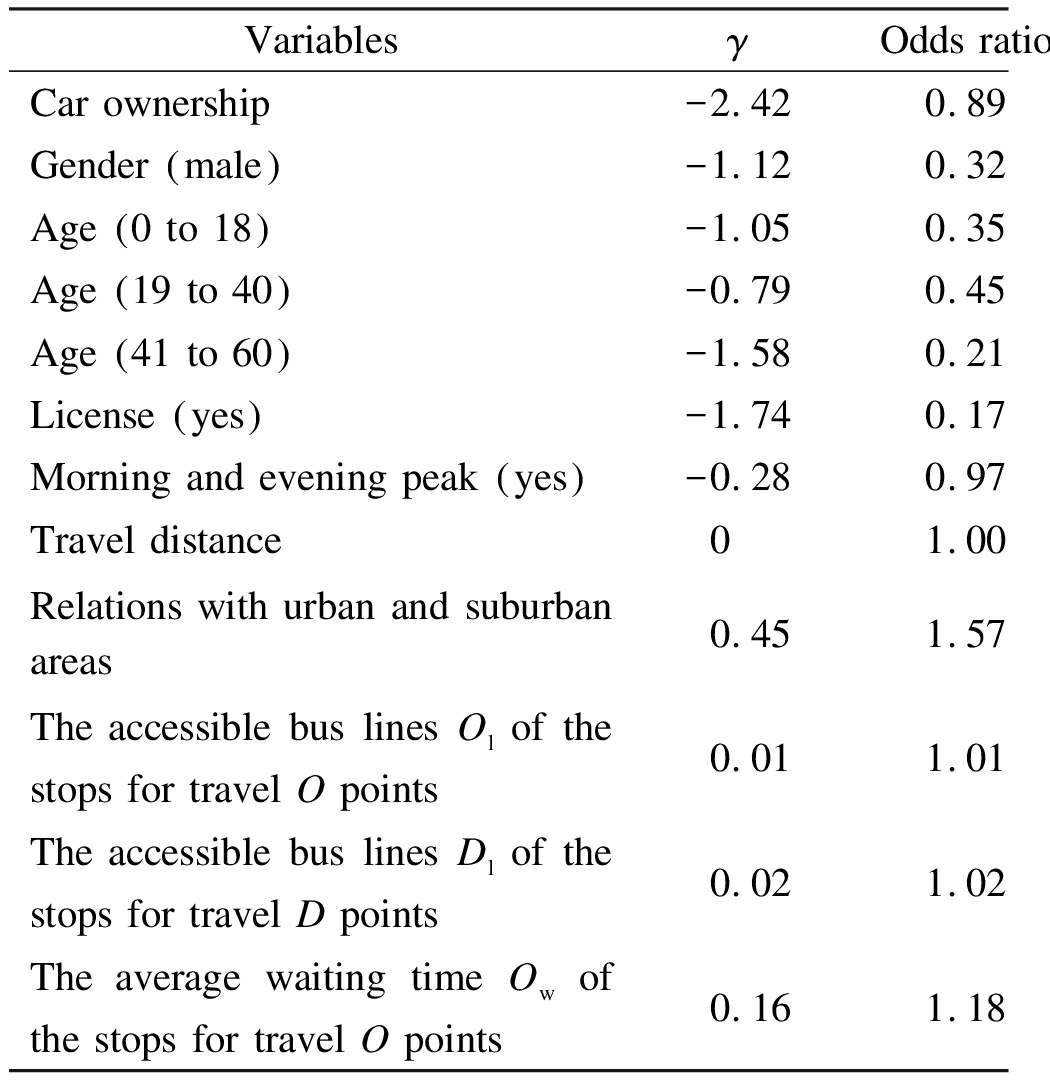Among the characteristics of the built environment, accessibility is one of the main factors in studies dwelling on travel mode choice. Etminani-Ghasrodashti et al.[1] have studied the influence of traffic accessibility, including the distance from home to the closest bus stop and intersection, where traffic accessibility has a significant impact on the residents’ travel mode choice. Low accessibility of public transport in the suburban areas was related to less use of public transport by the suburban residents and less cross-regional bus use by the urban residents[2]. This paper mainly studies the factors, especially the transit accessibility of stops, affecting the choice of travel mode of the suburban residents.
When studying the transit accessibility of stops and the corresponding networks, most scholars have considered a single variable to construct the travel mode choice model and not considered the correlations among variables[3-4]. Notably, travel time includes the walking time to stop, waiting, and travel time on the bus. The greater the proportion of the required walking time in the total travel time, the smaller is the advantage offered by that public transport. Indicators of the transit accessibility of stops are both constrained by the travel time. Therefore, this paper defines the indicators of the transit accessibility of stops as piecewise variables based on the travel time.
Many scholars have used disaggregated models to study the residents’ travel mode choices[5-7]. A disaggregated model takes each individual as an analytical unit to analyze the influence factors of travel mode choices, which is a discrete choice model based on the stochastic utility maximization theory. Such models are basically structured as binary[5], multinomial[6], and nested logic models[8] according to the response variables. In this paper, the research focuses on car and bus travel in the suburbs; hence, a binary logic model is used.
Residents of Jimei District in Xiamen, China, were used as a case study. Based on the survey data of the residents’ trips and GIS data on bus stops and travel OD points in this area, this paper uses the number of stops multiplied by the corresponding lines and average waiting time within the defined scope as the indexes of transit accessibility of stops. A binary logistic regression model is then constructed to empirically study the travel mode choice of suburbanites between cars and public transport.
1 Methodology
A binary logistic regression model of car and bus travel modes is constructed in this paper to explore the influence of the transit accessibility of stops on the travel mode choice of suburbanites, where the family attributes, personal characteristics, and travel characteristics of residents are considered as well. Specifically, relations with urban and suburban areas are factors involved in the travel characteristics, as travel in different areas may influence the choice of travel mode[9].
The latitude and longitude coordinates of origin and destination (OD) points obtained from the residents’ trip survey data and bus stops were stored in the ArcGIS software to analyze their spatial relationships. According to the provision of the service area of bus stops in the urban road traffic standard, the service area of bus stops should not be less than 50% of the urban land area calculated within a stop radius of 300 m and should not be less than 90% within a stop radius of 500 m[10]. To provide a basis for urban public transit optimization, this study selects the 300 and 500 m ranges as the reach of the transit accessibility of stops.
The transit accessibility range is determined by setting a given OD point as the center point and creating a 300- or 500-m radius around that point. In this paper, the indexes of the transit accessibility of stops are defined as the combination of the number of stops and the number of corresponding bus lines at the OD stop and the average waiting time at the origin stop. Fig. 1(a) illustrates the method for calculating the bus stop numbers. Fig.1(b) shows the actual bus stop accessibility. For example, stops “A” and “a” are two stops of the same name in the round-trip direction. If bus lines 1 and 2 pass through these two stops in the round-trip direction within the considered accessible range, the number of reachable stops is four for these two stops. In other words, the number of reachable bus lines can be calculated as the number of stops multiplied by the corresponding number of lines in the reachable area. The ideal average waiting time can be calculated by the 1/2 average headway of the number of reachable bus lines.

Fig.1 Transit accessibility of stops. (a) Method for calculating bus stop number; (b) Actual bus stop accessibility
As mentioned above, a correlation exists between the travel time of residents and transit accessibility of stops. In dealing with the transit accessibility of stops for residents based on travel OD points, piecewise variables are established using the constraint of travel time. The indexes of the transit accessibility of stops can be expressed as follows:
Ol=to1+(1-t)(o1+o2)
(1)
Dl=td1+(1-t)(d1+d2)
(2)
Ow=tOw1+(1-t)(Ow1+Ow2)
(3)
where Ol and Dl reflect the accessible bus lines of points O and D for the residents, respectively; Ow is the average waiting time of the origin stop; t is an indicative function, where a value of 1 indicates that the travel time is within a given set time span, and a value of 0 indicates that the travel time is beyond that time span; o1 and o2 are the products of the numbers of stops and lines in the 0 to 300 m and 300 to 500 m ranges from the origin, respectively; di(i=1,2) are defined for the destination in a similar way; Ow1 and Ow2 are the average waiting time, calculating the 1/2 average headway of the lines in the ranges of 0 to 300 m and 300 to 500 m, respectively. To make the average waiting time closer to that of the real scene in Xiamen, only bus trips with an average headway of less than 25 min are considered.
2 Data Sources and Descriptions
2.1 Description of the study area
This paper selects the residents of Jimei District in Xiamen as a case study. According to the data from Xiamen in 2010, 60% of the jobs in the city are located on Xiamen Island[11]. Due to the lack of public transportation facilities, the separation of residential and employment activities between Jimei District and the urban center has caused a rapid increase in car ownership and stimulated the demand for car travel. By the end of 2014, the number of registered motor vehicles reached approximately 178 000 or up to 14.34% from the previous year, and the bus sharing rate was only 35% in Jimei District[12]. This value is lower than the bus sharing rate of the entire city (44.3%)[13]. To study the impact mechanism of the low bus sharing rate in the suburban area, this research focuses on the travel behavior of suburban residents in Jimei District.
2.2 Research data
The data used in this paper were obtained from resident trip surveys in Xiamen in 2016, which were recorded by electronic equipment. Through these surveys, detailed personal travel information from a random sample (individuals aged 6 years and above) of households was collected in Xiamen City. The survey was divided into three parts: family characteristics, personal characteristics, and daily travel characteristics. Tab.1 shows the statistical results.
According to the survey, the average travel time of the
Tab.1 Variables of influence from the trip surveys of suburban residents

CategoryVariableClassificationSample sizeFrequency/%Dependent variableTravel modePublic transport33534.32Car64165.68Family attributesCar ownershipYes65066.60No32633.40PersonalcharacteristicsGenderAgeMale57959.32Female39740.680 to 18767.7919 to 4061563.0141 to 6024324.90≥61424.30TravelcharacteristicsLicenseMorning and evening peakTravel time/minTravel distanceYes65166.70No32534.30Yes49550.72No48149.28≤3071072.75>3026627.25Occurrence976100.00Travel ODpropertiesRelations with urban andsuburban areasUrban and suburban22122.64Suburban and suburban75577.36
residents in Xiamen City and Jimei District is 25.52 and 23.66 min, respectively. In addition, 72.75% of the residents in Jimei District travel within 30 min, and the mode, which is the value that occurs most frequently, of the residents’ travel time is 30 min. Therefore, a trip of 30 min is used as a critical value to construct piecewise variables for the transit accessibility of stops. That is, when the trip time is within 30 min, public transportation facilities within 300 m are selected to determine the transit accessibility indexes. When the trip time exceeds 30 minutes, public transportation facilities within 500 m are selected to determine the transit accessibility indexes.
The location information for 976 OD pairs of residents in Jimei District can be associated with the GIS data for the stops of all bus lines in Xiamen. Meanwhile, the reachable ranges of 300 and 500 m for OD pairs are established in ArcGIS using a buffer analysis (see Fig. 2). The indexes of transit accessibility of stops can then be calculated.
3 Model Results
Tab.2 presents the estimated results of the binary logistic regression model of the suburban resident travel mode choice. Model results suggest that the variables of the transit accessibility of stops can significantly influence the choice of travel mode (p<0.01). The likelihood of choosing public transport increases by 1.01 times

Fig.2 Accessible bus lines of stops based on travel OD points
as the accessible bus lines of the stops increase, but there is almost no difference in the travel mode choice between the accessible bus lines of the stops for point O and point D. At the same time, the likelihood of choosing public transport increases by 1.18 times as the average waiting time reduces. In addition, links with urban and suburban areas have a significantly positive effect on public transport travel, and the travelers within the suburban areas are 1.57 times more likely to choose public transport.
In terms of family attributes, car ownership has a significantly negative effect on the public transportation choice
Tab.2 Results of binary logistic regression model of suburban residents’ travel mode choice

VariablesγOdds ratiopCar ownership-2.420.890.000Gender male -1.120.320.000Age 0 to 18 -1.050.350.180Age 19 to 40 -0.790.450.270Age 41 to 60 -1.580.210.030License yes -1.740.170.000Morning and evening peak yes -0.280.970.908Travel distance01.000.939Relations with urban and suburban areas0.451.570.240The accessible bus lines Ol of the stops for travel O points0.011.010.000The accessible bus lines Dl of the stops for travel D points0.021.020.000The average waiting time Ow of the stops for travel O points 0.161.180.002
of suburban residents. Thus, if a family has a higher car ownership level, the family is less likely to choose public transport. All personal characteristic variables, including gender, age, and the possession of a license, significantly influence the choice of travel mode. Specifically, males are 3.13 times less likely to choose public transportation than females; people under the age of 60 are less likely to choose public transportation; and people who have a driver’s license are 5.88 times less likely to choose public transportation. Among the travel characteristic variables, morning and evening peaks have insignificant effects on the travel mode choice. A possible reason may be that the travel delay caused by the morning and evening peak congestion in Xiamen is not so serious. In addition, travel distance has little effect on the choice of travel mode. Xiamen is an island-type city. Traveling from suburban to urban areas involves a long travel distance due to the bridges required to travel into and out of the island area.
These findings indicate that among family attributes, personal characteristics play negative roles in the selection of public transport travel (γ<0), and travel OD properties facilitate public transport travel (γ>0). The model results for the travel mode choice confirm the importance of the transit accessibility of stops in public transportation. Improving the suburban public transport planning can serve as a key strategy to increase the stop transit accessibility and to encourage the use of public transport.
4 Conclusions
1) The transit accessibility of stops had a positive influence on the choice of public transportation. With a higher transit accessibility of stops, bus transport becomes a more attractive transport mode and residents are more likely to choose public transport. The increasing number of accessible bus lines indicates the increasing opportunity of choice. Waiting time is an important part of the total travel time, which affects the travel experience of passengers.
2) The indicators of the transit accessibility of stops are constructed as piecewise variables to reflect the correlations between the travel time and accessible range. According to this research, it is insufficient to simply consider the transit accessibility of stops within the range of 300 or 500 m. The total travel time of this segment should be made based on the scale of the specific city, and cities of different sizes may use different time spans.
3) Family attributes and personal characteristics are strongly correlated with the choice of travel mode of suburban residents. The travel characteristics have no significant influence on the residents’ travel mode choices. In addition, compared with the travel between the suburban and urban areas, residents often chose public transport for travel within the suburbs.
[1]Etminani-Ghasrodashti R, Ardeshiri M. Modeling travel behavior by the structural relationships between lifestyle, built environment and non-working trips[J].Transportation Research Part A: Policy and Practice, 2015, 78: 506-518. DOI:10.1016/j.tra.2015.06.016.
[2]Cheng J, Yan R Y, Gao Y E. Exploring spatial heterogeneity in accessibility and transit mode choice[J]. Transportation Research Part D: Transport and Environment, 2020, 87: 102521. DOI:10.1016/j.trd.2020.102521.
[3]Munshi T. Built environment and mode choice relationship for commute travel in the City of Rajkot, India[J]. Transportation Research Part D: Transport and Environment, 2016, 44: 239-253. DOI:10.1016/j.trd.2015.12.005.
[4]Nassir N, Hickman M, Malekzadeh A, et al. A utility-based travel impedance measure for public transit network accessibility[J]. Transportation Research Part A: Policy and Practice, 2016, 88: 26-39. DOI:10.1016/j.tra.2016.03.007.
[5]Chakrabarti S. How can public transit get people out of their cars? An analysis of transit mode choice for commute trips in Los Angeles[J]. Transport Policy, 2017, 54: 80-89. DOI:10.1016/j.tranpol.2016.11.005.
[6]Guan J P, Xu C Z. Are relocatees different from others? Relocatee’s travel mode choice and travel equity analysis in large-scale residential areas on the periphery of megacity Shanghai, China[J]. Transportation Research Part A: Policy and Practice, 2018, 111: 162-173. DOI:10.1016/j.tra.2018.03.011.
[7]Orsi F, de Geneletti D. Assessing the effects of access policies on travel mode choices in an Alpine tourist destination[J]. Journal of Transport Geography, 2014, 39: 21-35. DOI:10.1016/j.jtrangeo.2014.06.015.
[8]Ghader S, Carrion C, Tang L, et al. A copula-based continuous cross-nested logit model for tour scheduling in activity-based travel demand models[J]. Transportation Research Part B: Methodological, 2021, 145: 324-341. DOI:10.1016/j.trb.2021.01.001.
[9]DeSalvo J S, Huq M. Mode choice, commuting cost, and urban household behavior[J]. Journal of Regional Science, 2005, 45(3): 493-517. DOI:10.1111/j.0022-4146.2005.00381.x.
[10]Ministry of Housing and Urban-Rural Development of the People’s Republic of China. Code for planning and design of urban road traffic: GB 50220-95[S]. Beijing: MOHURD, 1995.(in Chinese)
[11]Meng Y P. The influence of spatial distribution characteristics of residence and employment on commuting traffic in Xiamen[C]//Annual National Planning Conference. Kunming,China, 2012:143-149 .
[12]China Highway Engineering Consulting Group Co., Ltd. Planning research text of parking layout optimization in Jimei district[R]. Xiamen, China: China Highway English Consulting Group Co., Ltd., 2016.
[13]Xiamen public transport network density of 4.05 km / km2, higher than standard in China[EB/OL]. (2016-08-10) [2020-01-17]. https://www.sohu.com/a/109829518_257343.